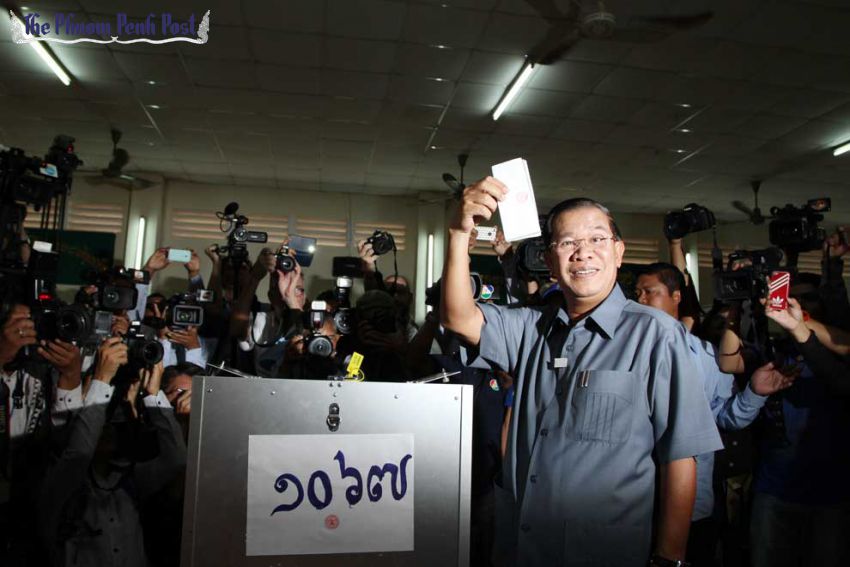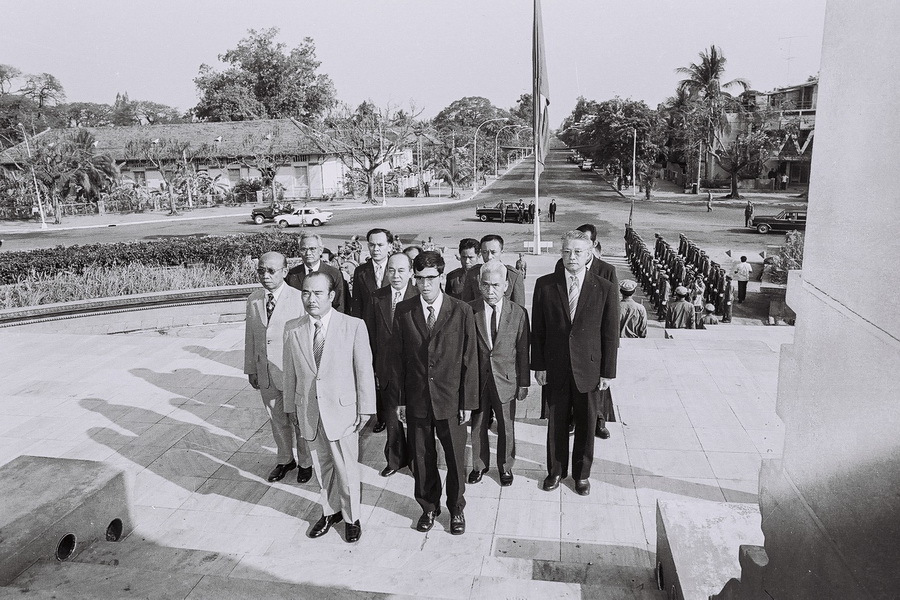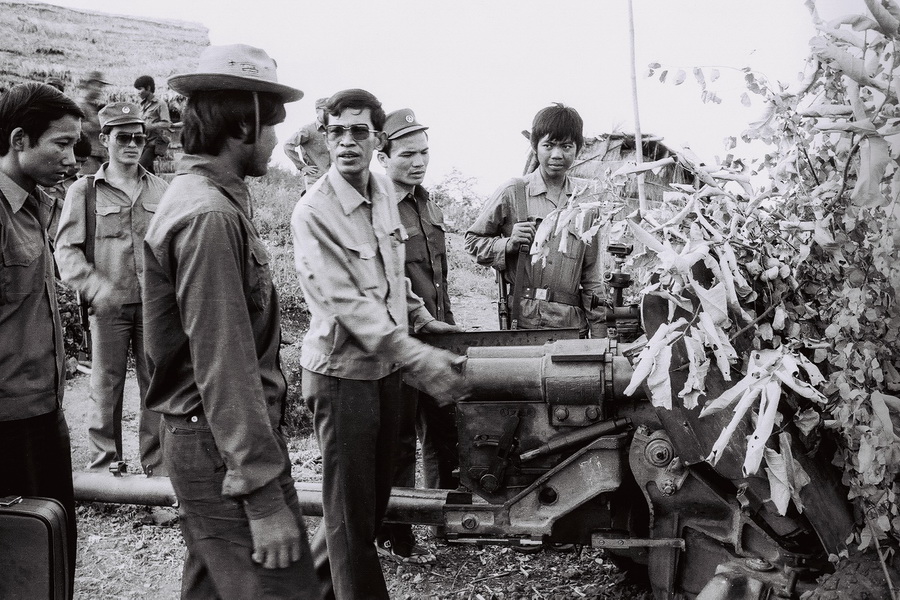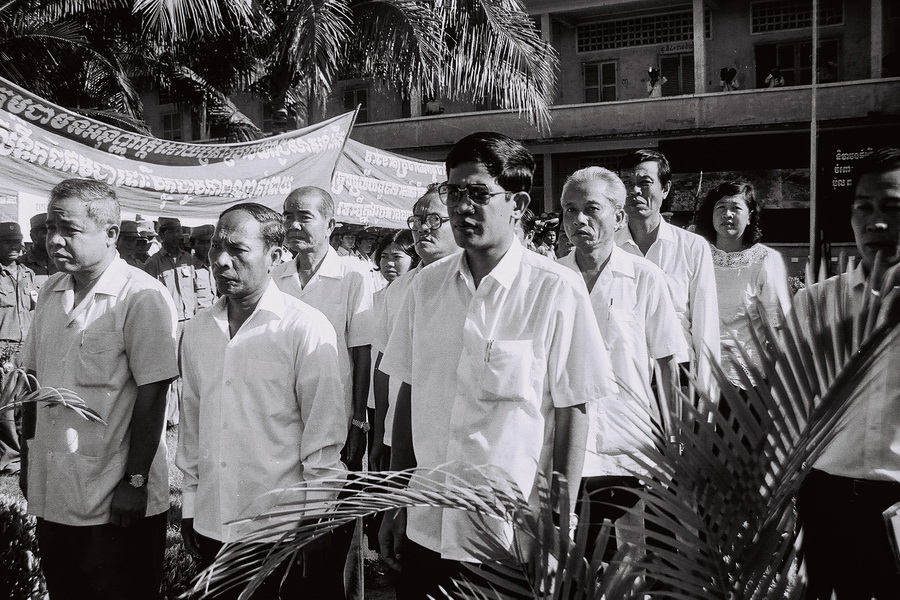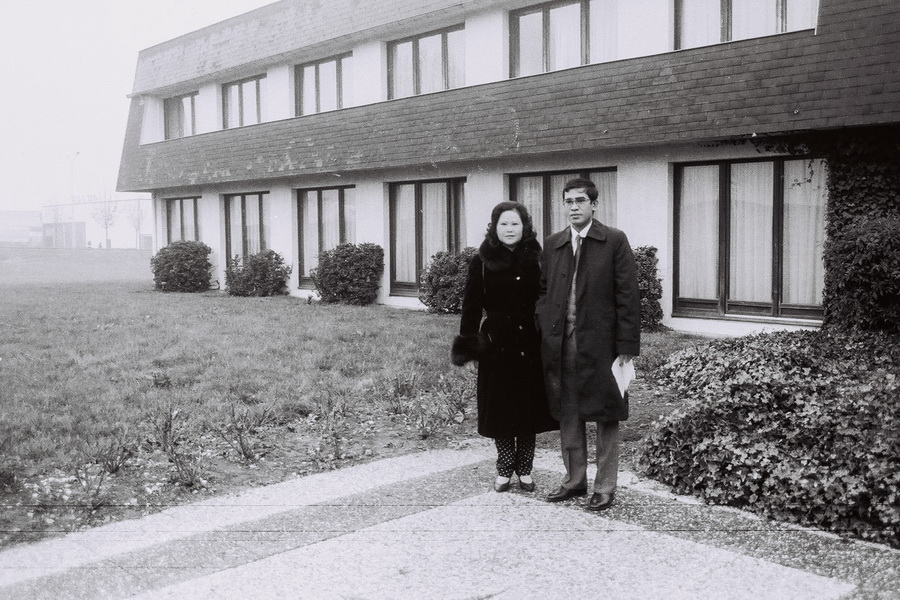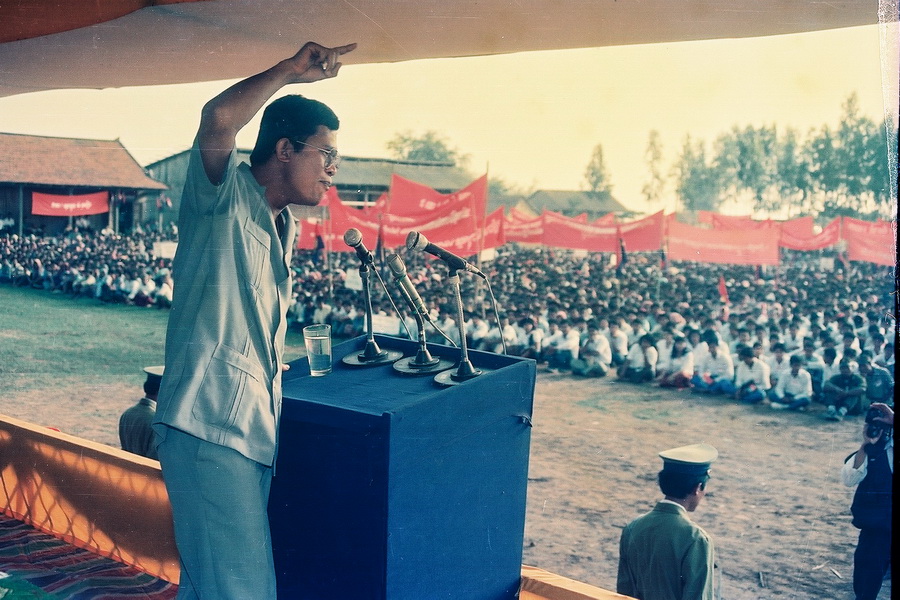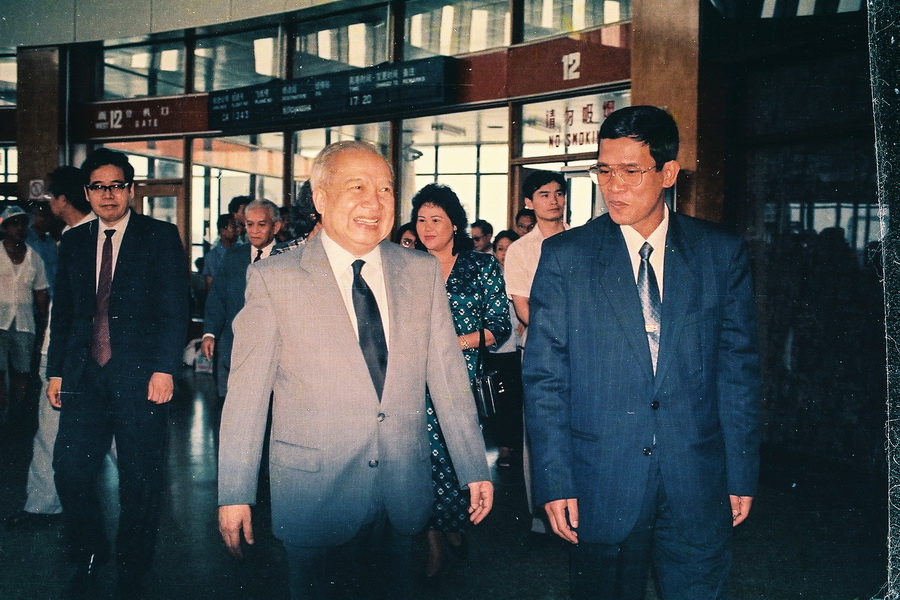Thirty years ago, Hun Sen was appointed prime minister of Cambodia. By remaining at the helm of the country’s turbulent politics until the present, Hun Sen now sits alongside the world’s longest-serving political leaders.
On September 3, 1997, Thomas Hammarberg, the UN secretary-general’s special representative for human rights in Cambodia, was invited to a meeting with the country’s second prime minister, Hun Sen. Hammarberg had good reason to expect a tense reception. Two months earlier, security forces loyal to Hun Sen and his Cambodian People’s Party (CPP) had launched lightning strikes against the private army of the first prime minister, Prince Norodom Ranariddh of the royalist Funcinpec party, killing dozens of key commanders and driving many more opponents into exile.
In the aftermath, Hammarberg and staff at the UN Centre of Human Rights got to work documenting the violence. The UN’s 50-page report, released that August, outlined the campaign of executions, torture and disappearances that accompanied the July 5-6 fighting. Particularly, it named 41 Funcinpec figures who had been killed following their arrest by CPP forces and recommended the government conduct a “serious criminal investigation” into each.
Hun Sen wasn’t pleased. His government had defended the CPP strikes as a pre-emptive law-and-order operation, and he had always bristled at the UN’s “interference” in his country’s affairs.
The Swedish diplomat and the Cambodian politician were a study in contrasts. The 55-year-old Hammarberg had dedicated his career to the advancement of human rights and a more just international order. His CV included stints as head of the Swedish branch of Save the Children and as secretary-general of Amnesty International, on whose behalf he had received the 1977 Nobel Peace Prize.
His blond hair now fading to white, Hammarberg cut a patrician figure next to the boyish Hun Sen, 10 years his junior. Largely self-taught, with his rough peasant edges only partly smoothed down by a well-cut suit, Hun Sen had known little but war and political struggle. Since being appointed foreign minister after the overthrow of the Khmer Rouge regime in January 1979, he had clawed his way to the peak of Cambodian politics, where he was now determined to remain.
As Hammarberg remembered it, this meeting of opposites in September 1997 got off to a surreal start. As soon as he had arrived and was seated, Hun Sen motioned to an aide. A door opened, and about 20 uniformed soldiers filed into the room. Here, Hun Sen announced, were the men listed as killed in the UN’s report into the July 1997 clashes. Hammarberg recalled Hun Sen’s sarcastic response: “They look very much alive, don’t they?”
The Swede was taken aback. But he was also confident of his research. The UN team had probed each case in painful detail, exhuming blindfolded corpses and conducting dozens of interviews. Only those allegations that had been fully verified were included in the final report. As he went through the report with Hun Sen, Hammarberg realised these “dead men walking” were an elaborate bluff. Once he made this clear to Hun Sen, the Cambodian politician “sort of lost face”, Hammarberg recalled. “His way of handling the meeting just collapsed.”
While Hun Sen was forced to back down, it wasn’t long before he resurrected the stunt. In early 1998, Mary Robinson, the UN High Commissioner for Human Rights, arrived in Cambodia on a much-publicised visit. During a meeting with Robinson on January 23, Hun Sen surprised the former Irish prime minister by producing four men – again, very much alive – whom the UN had supposedly declared dead. Hun Sen then paraded the men during a joint press conference with Robinson, condemning the UN and warning that his government would refuse to cooperate with “people who violate us, who abuse us, or distort us”.
A former soldier, he saw power not as a matter of principle, but as a function of force and interests. Everything else, whether human rights or democratic norms, was window-dressing.
Again, it was a bluff. Hammarberg later clarified that none of the men were listed as killed in the report – the first didn’t appear in it at all; the second and third had been reported missing (but not killed); and the fourth was the brother of two who had been killed in July 1997 – and was now being used in an attempt to exonerate the party responsible for his siblings’ deaths. The press conference was staged on a Friday afternoon; by the time the story could be corrected, it had already been parroted widely in the Khmer-language press.
The cosmopolitan Hammarberg recalled being flummoxed by Hun Sen’s theatrics. “Not only had he pulled the trick again, but he had also pushed relatives of those who had been killed to be witnesses to undermine the report,” he said. “That was his style.”
In truth, Hammarberg and his Cambodian interlocutor represented radically divergent world views. Where Hammarberg was an idealist, Hun Sen understood reality and the ways in which it could be bent to his will. Where the Swede envisioned a world governed by universal norms, the Cambodian bristled at any suggestion that the same standards should apply in Phnom Penh as in New York or Stockholm or Geneva.
In place of the enlightened deliberation represented by the UN, Hun Sen inhabited a world of zero-sum political struggles. A former soldier, he saw power not as a matter of principle, but as a function of force and interests. Everything else, whether human rights or democratic norms, was window-dressing – of little consequence to whom ultimately came out on top. “What are international standards?” Hun Sen was fond of asking. “I don’t understand. International standards exist only in sports.”
Enlightened or not, Hun Sen’s political intuitions have proved remarkably durable. Thirty years ago today, the Cambodian National Assembly voted to appoint Hun Sen as prime minister, at the age of just 32. Since then, his Machiavellian political style has seen him through repeated cycles of the country’s turbulent history, through three decades of civil war and political upheaval, the collapse of communism, and the country’s transition to democracy.
Now 62, Hun Sen stands as one of the great political survivors, the longest-serving non-monarch in Asia, and one of the longest-serving prime ministers in the world. With about 65.3 per cent of Cambodians today under the age of 30, according to the UN, the majority of the population now has no memory of anyone else.
Over the course of his career, Cambodia’s prime minister has played many roles: communist soldier, socialist apparatchik, international statesman, free-market reformer, demagogic demigod. But if Hun Sen’s career has had one constant, it has been his ideological flexibility.
“He is not hard-headed,” a CPP insider said this week, on condition of anonymity. “He knows how to move in accordance with the situation, like a boat sailing on the Mekong River.”
* * * *
THE village of Peam Koh Snar stretches out along a wide brown bend of this same great waterway, about 40 kilometres northeast of Kampong Cham city. It is peaceful and orderly. The houses are wooden with tiled roofs, lined by tobacco fields and rice paddies. The village has a well-sealed road that runs over a small steel bridge flanked by seven-headed concrete nagas. Not far away, there is a new pagoda dedicated by Hun Sen’s relatives and a primary school named after his brother, the former provincial governor Hun Neng: over the years, Peam Koh Snar has been a special subject of strongman charity.
On August 5, 1952, Cambodia’s future leader was born here in a brown stilt house just off the main village road. Locals still express affection for the local boy who conquered the heights of Cambodian politics. “All the villagers are proud of him,” said Nin Kimsoeun, 31, a second cousin of Hun Sen who looks after the prime minister’s childhood home, welcoming curious visitors. “He has helped a lot of people here.”
Down the road, 68-year-old Ros Thorn sat on a concrete table under a tree at Wat Botum Kesor. Brown cupping marks covered his forehead, and a light blue towel lay draped around his neck. Thorn recalled the skinny youth before he was sent by his parents to study in Phnom Penh in 1965, at the age of 13. “Hun Sen was not only a good student; he was good at everything,” he said.
Not long after leaving Peam Koh Snar, Hun Sen was swept up in the tumult of modern Cambodian history. Sometime in the late 1960s – it is unclear exactly when – he left school and joined the communist insurgency opposing the government of Prince Norodom Sihanouk. Throughout the 1970s, Hun Sen fought for these “Khmers Rouges”, as Sihanouk dubbed them, losing an eye to a piece of artillery shrapnel as the communists closed in on Phnom Penh in April 1975.
Hun Sen has since claimed he was shocked by the radical experiment set in motion by the new leaders of “Democratic Kampuchea”, and had no hand in atrocities committed by the regime, which led to the deaths of an estimated 1.7 million Cambodians. In mid-1977, after rising to the rank of deputy regimental commander, Hun Sen defected to Vietnam to escape the regime’s purges.
When the Vietnamese army overthrew the Khmer Rouge in January 1979, Hun Sen became foreign minister in the socialist clone administration they installed in its place. Closely mentored by Ngo Dien, Vietnam’s ambassador in Phnom Penh, he quickly evolved into a loyal and reliable ally. In late 1984, when Prime Minister Chan Si died in Moscow, Hun Sen was the obvious choice as successor.
He took the reins in a turbulent period. Throughout the 1980s, his People’s Republic of Kampuchea, supported by a Vietnamese occupation force and millions of rubles in Soviet aid, fought a bitter Cold War proxy conflict against a Chinese- and US-backed resistance coalition, which included the Khmer Rouge. In a cruel twist of Cold War realpolitik, the Khmer Rouge continued to represent Cambodia in the UN, while the PRK and its Vietnamese patrons were subject to a Western embargo. For a young Hun Sen, the decade would leave a deep impression. It instilled a conviction that for superpowers like the US, human rights and democratic norms were very often simply means to a political end. Why should those same norms bind him?
In 1989, the Berlin Wall fell and the paralysing polarities of the Cold War gave way to a new era of promise. In Cambodia, the end of the Cold War led to the withdrawal of Vietnamese forces from the country and the signing of the Paris Peace Agreements on October 23, 1991. The treaty created the UN Transitional Authority in Cambodia (UNTAC) of 1992-93, which had a mission to end the civil war and hold democratic elections. With the UN’s arrival, Cambodia became a laboratory of the post-Cold War international order. Phnom Penh went from being an impoverished socialist capital to a postmodern treaty port city, forced open not by colonial gunboat diplomacy but by international aid and the wave of foreign consultants and NGO workers that followed.
The leaders in Phnom Penh saw the arrival of the UN and its civil war-era enemies as a hindrance and a threat. But Hun Sen quickly saw through the triumphalist language of the age to the brittle political commitments that lay beneath. Despite all the talk of bringing democracy and international norms to Cambodia, foreign governments had crafted the Paris Peace Agreements in order to detach them from the country’s political squabbles, not to deepen their involvement. This was illustrated starkly in the aftermath of the UN-organised 1993 election, which the CPP lost to Prince Ranariddh’s Funcinpec.
“He knows how to move in accordance with the situation, like a boat sailing on the Mekong River.”
In the days following the election, CPP figures threatened violence, announced a secession of the country’s eastern provinces, and thus strong-armed their way into an equal share of power. In an undemocratic arrangement that could only have been cooked up by Cambodian politicians, Hun Sen became “second” prime minister to Ranariddh’s “first”. There was nothing much the UN could do.
Having already declared the election a success, it packed up and left.
The next four years were marked by intrigue and political struggle as the two prime ministers vied for supremacy – a struggle that eventually came to a head in July 1997 in the streets of Phnom Penh. Despite initially protesting the violence, most foreign governments accepted the status quo when a chastened Ranariddh returned to contest a new election in July 1998. This time, the CPP won.
The election was flawed, but it was enough for most foreign governments to resume their aid. Once again, Hun Sen ruled alone.
There he has remained ever since, using guile and threats to neutralise his remaining opponents and consolidate his control over the courts, parliament and armed forces. According to Human Rights Watch, hundreds of politicians, union leaders and journalists have been killed in politically motivated attacks since the late 1990s; virtually no one has been brought to justice. Violence has since receded in Cambodian politics just as most national institutions – from the Buddhist monkhood and the monarchy to the boy scouts and the Cambodian Red Cross – have been “harmonised” with the CPP’s political consensus.
Today, true power resides not in the democratic institutions imported by the UN, but in the flows of influence and mutual obligation linking Hun Sen with dense networks of business and political elites. “Human rights [and] political space still depends on his mood,” said Thun Saray, the director of the human rights group Adhoc. “It’s a rule of man.”
Even so, the outward forms of democracy remain. Even before UNTAC, Hun Sen recognised the value of a good performance. In the late 1980s, as peace beckoned, he became a key advocate of cosmetic reform – of exchanging a “red” shirt for a “blue” one. By abandoning communism and adopting the language of pluralism, he argued that his party could survive the transition to democracy and maintain its grip on power. And so, Hun Sen grew into a skilled peddler of promises, fluent in donor-speak, conjuring up dreams and illusions of reform to placate the foreign governments that still give hundreds of millions in aid each year.
At the same time as he has played bait-and-switch with foreign donors, Hun Sen’s local stature gained new dimensions. State propaganda now depicts him as a benevolent peasant king, raining blessings on the people. He smiles down from party billboards across the country. His name is attached to thousands of schools bankrolled by friendly oligarchs. His personality finds its full expression in long speeches in which he scolds and jokes and threatens, instilling in his rural audiences a particularly Cambodian blend of fear and awe.
A son of the soil, Hun Sen has been able to manipulate the fears and hopes of rural people effectively, depicting the choice between the CPP and its opponents as a choice between stability and chaos, between a chance of a better future and a return to the horrors of the past. In his first speech of 2015, Hun Sen brusquely declared that anyone still opposing him was “an ally of the Pol Pot regime”. Under the peasant king, there is no middle way.
* * * *
HUN Sen’s long reign has provoked sharply divergent opinions. Overseas, the Cambodian premier has been often vilified as a brutal dictator who thwarted Cambodia’s chance at democracy. In July 1997, the described him as “Hun the Attila”. In a May 2012 article marking Hun Sen’s 10,000th day in power, Brad Adams, the Asia director of Human Rights Watch, compared him to recently deposed Libyan strongman Muammar Gaddafi.
But others also point out that Hun Sen has presided over a long period of political stability and economic growth – rare commodities in a country that has never known any sort of popular sovereignty. In the decade after 1998, Cambodia’s GDP grew by nearly 10 per cent per annum, one of the fastest growth rates in the world. “He is the right man at the right time,” said Phay Siphan, a spokesman for the Council of Ministers.
Many foreign officials who have dealt with Hun Sen say that while he could be violent and unstable, he was one of the few effective leaders in the egotistic aviary of Cambodian politics. One Western ambassador posted to Phnom Penh in the mid-1990s contrasted Hun Sen’s single-minded focus and capable support staff to the court-like sycophancy that surrounded his coalition partner, the “petit prince”, Ranariddh. Charles Ray, who represented US interests a decade later, described Hun Sen as one of the few politicians whose word he believed he could trust.
At its core, this divergence of opinions represents a disagreement over whether Hun Sen’s rule should be judged against an international standard, or in the light of his country’s particular history and circumstances. Both offer insights into Hun Sen’s rule. On the one hand, the premier deserves credit for presiding over a long spell of stability and development, in a manner mostly consistent with past generations of Cambodian leaders. On the other, the contradictions of his rule have scarcely been more apparent.
Since the end of the civil war in the late 1990s, stability has come at a steep price for many Cambodians. To maintain the loyalty of powerful tycoons, the Cambodian government has allowed them to strip the country’s resources and fell its once-abundant forests. An economic revolution has been accompanied by land grabs, impunity, and a widening gulf between rich and poor. Despite the CPP’s frequent gifts of schools and pagodas, many rural poor still live on a knife-edge.
All the while, Hun Sen has become an Olympian figure, coddled by yes-men and insulated from the realities of his rapidly changing country. Sam Rainsy, the leader of the opposition Cambodia National Rescue Party (CNRP), likened him to a boat’s captain who is so absorbed with trying to avoid the rocks that he has lost track of where he is sailing. “He is very good at daily survival, but he has no vision,” Rainsy said.
This rising discontent lay behind the surprising result of the July 2013 national election, when the CPP’s majority plummeted from 90 National Assembly seats out of 123 to just 68 following large gains by Rainsy’s CNRP. After the election, the CNRP claimed that it actually would have won were it not for large-scale voter fraud, and announced a boycott of the new National Assembly pending an investigation of the election. The huge crowds of young people that took to the streets in support of the CNRP’s demand were an ominous sign for Hun Sen.
A man of his political intuitions can’t have failed to grasp that the CPP had overreached. Straight away, the promises came. Reforms were launched in education and environmental policy, while key ministries were reshuffled. At the same time, however, the CPP moved to quash any possibility of an opposition alternative. Armed thugs were deployed against opposition protests. On January 3, 2014, security forces fired at striking garment workers on the outskirts of Phnom Penh, leaving five dead.
Throughout the post-election tumult, Hun Sen remained unbowed. He showed no apparent remorse for those killed in the garment crackdowns, warning that he would meet further protests with even bigger demonstrations of his own. “Do you want to know or try a taste?” he asked. “If Hun Sen comes out to do something, it’s not going to be small.”
Hun Sen has become an Olympian figure, coddled by yes-men and insulated from the realities of his rapidly changing country.
But with the next national election due in 2018, Hun Sen now faces perhaps the greatest challenge of his career: to bring promised reforms without undermining the powerful interests that have bankrolled his long reign. After so many twists and turns, does an ageing leader have the energy for another rebranding? The CPP insider predicted that Hun Sen would rise to the challenge. “Hun Sen will hold the prime minister’s seat until his retirement,” the official said.
It would be foolish to rule it out. Already, the CPP is moving the chess pieces into place as it seeks to wear down the CNRP. Despite agreeing to end its parliamentary boycott in July 2014 in exchange for a handful of political concessions, opposition figures remain in court, and the party is cowed. Last month, Prince Ranariddh was wheeled out of retirement to take the reins of his old party, Funcinpec, admitting Hun Sen had “played a clear role” in his return, in a presumed attempt to draw support away from the CNRP.
Ou Virak, former chairman of the Cambodian Center for Human Rights, said Hun Sen was again using the divide-and-rule strategies that have served him so well, but this time with more of an eye to public opinion. “Hun Sen was very arrogant in 2013 when he discounted the rise of the young population with smartphones in their hands,” he said. “He won’t make that same mistake in 2018.”
Virak said Hun Sen is a born fighter with the stamina to keep ruling Cambodia beyond the next election, but said he would also be preoccupied with readying a succession plan, perhaps smoothing a transition to one of his sons.
Whatever happens, Cambodia’s leader clearly still has a few battles left to fight. In the past, Sam Rainsy has depicted his rival as an anachronism, standing on the wrong side of history. But Hun Sen’s singular ability has been to shape history to his liking, whatever the costs to his people. Only time will tell who has a firmer grasp of changing Cambodian realities.
Published in the Phnom Penh Post, January 14, 2015



